10 REASONS NOT TO GET ARTIFICIAL GRASS
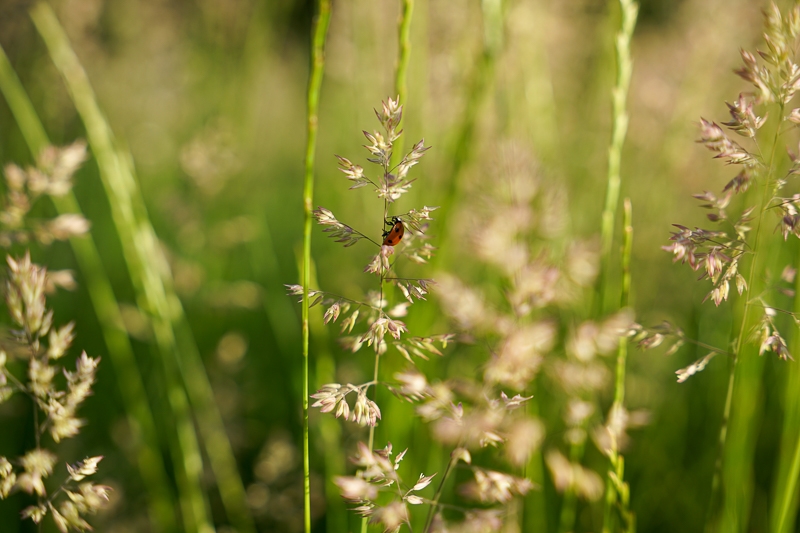
Let’s talk about artificial grass.
When I started writing this post, I worried that bashing artificial grass was a bit over-done. Surely, by now, everyone knows the damaging impacts. It appears not.
When I search ‘artificial grass’ on Twitter, most of the Tweets that appear are from people saying they want artificial grass, or from companies that install it. When I Google ‘artificial grass’, nothing on the first five pages covers the problems with plastic lawns, except a news story about the risk of flash floods – I only stop at page five due to a petition to ban fake grass, but there are many more search result pages without impartial information too.
SO, WHAT ARE THE PROBLEMS?
Let’s cut to the chase. Here’s a non-exhaustive list of the problems with artificial grass.
1. NOTHING LIVES IN PLASTIC
I’m opening with the blindingly obvious. Next to nothing lives in plastic lawns. We’re in the midst of a biodiversity crisis. Our insect numbers are in spiralling decline and our survival (as well as the survival of most other creatures on Earth) relies on insects.
Bees buzzing around clover, ladybirds on daisies, early birds getting the worms? Not things you’ll see on a plastic lawn. Covering the soil has a negative impact on the creatures who live below the surface and denies access to food sources for hedgehogs and birds, affecting their population numbers, as well as access to soil for ground-nesting bees.
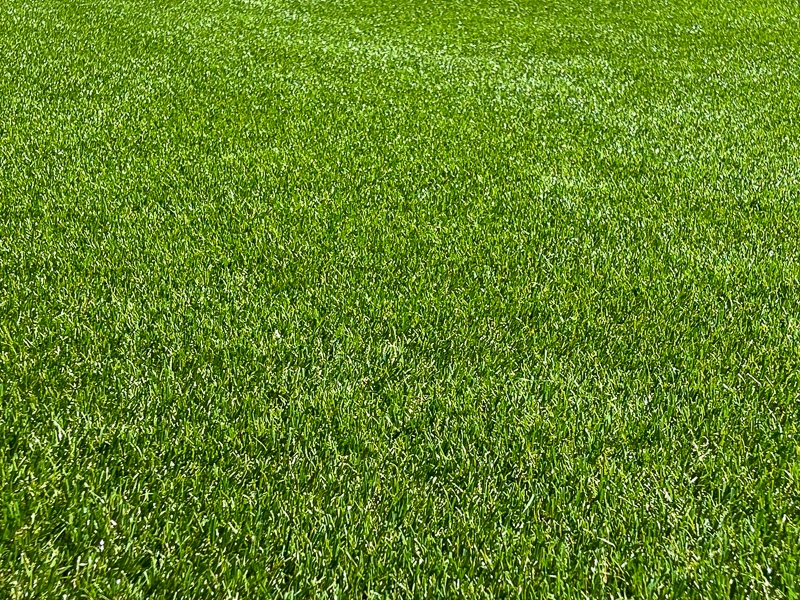
Spot the life in this plastic grass (spoiler alert: there is none)
2. MICROPLASTICS
Plastic lawn sellers will, unsurprisingly, tell you they’ve developed plastic grass that ‘doesn’t shed’. Experts think this is unlikely.
It’s much more likely that fake lawns are shedding microplastics into our environment constantly. A study on sources of microplastics on the Swedish coast estimated a loss of 2,300-3,900 tonnes of microplastics per year from artificial turf.
Microplastics from artificial turf have been recognised in Sweden as the second largest source of microplastic pollution, after car tyres. Microplastics pollute the environment and enter the food chain, working their way up the chain by trophic cascade to predators (including humans).
3. CARBON FOOTPRINT
Plastic production has a heavy carbon footprint. Most types of plastic are made from fossil fuels. The factories that make the plastics often run on fossil fuels, and fossil fuels are often used to attain the high temperatures needed during processing.
You’ve also got the carbon footprint of storing and transporting the plastic grass.
On top of all this, remember that real grass absorbs carbon all day long – like any photosynthesising plant, it takes carbon dioxide from the air and releases oxygen. Plastic grass does no such thing – worse, the installation process usually involves removing a lot of soil, which releases carbon into the atmosphere.
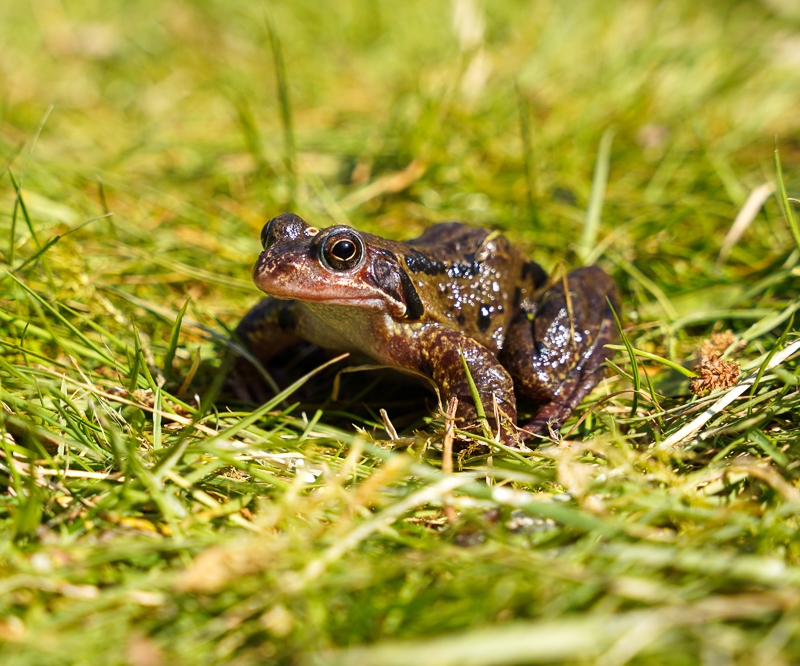
Wildlife thrives in real grass
4. IT’S NOT LOW MAINTENANCE
Fed up with mowing and think plastic grass will ease your woes? Think again.
If you follow Stacey Solomon on Instagram, you’ll know what I’m getting at here. You might have weaselled out of mowing, but now you’ll be hoovering your grass. Yep, you, your plastic lawn, and Henry the Hoover.
Guides like Carpetright’s on how to care for your fake lawn are lessons in how to cause yourself a load of work and cause even more environmental harm at the same time. Carpetright recommend:
Brushing your lawn every week (or every other week).
Regularly removing leaves.
Applying weedkiller twice a year to the whole area (devastating your garden’s dwindling ecosystem).
Using an artificial turf spray to clean your pets’ urine from the plastic grass before sprinkling the area with baking soda and vinegar to prevent odours.
Raking the grass regularly.
Picking weeds out of the grass.
Moving all your garden furniture around every now and again.
Trimming hedges and trees to minimise leaves falling onto the plastic grass.
Thoroughly cleaning any spills (drinks, etc.) as these will stain the plastic grass.
This is without even getting into all the work you’ll incur if your plastic lawn suffers from drainage issues, lifting edges, moss growth, surface heat issues or visible joint lines. And Carpetright didn’t mention the horror of trying to clean pet poo off plastic grass (yep, that’ll count as a stain you’ll need to scrub…)
Contrast this to how I care for my lawn – by mowing it a few times a year – and you’ll see that plastic grass will cause you at least as much work as a living lawn, and probably more.
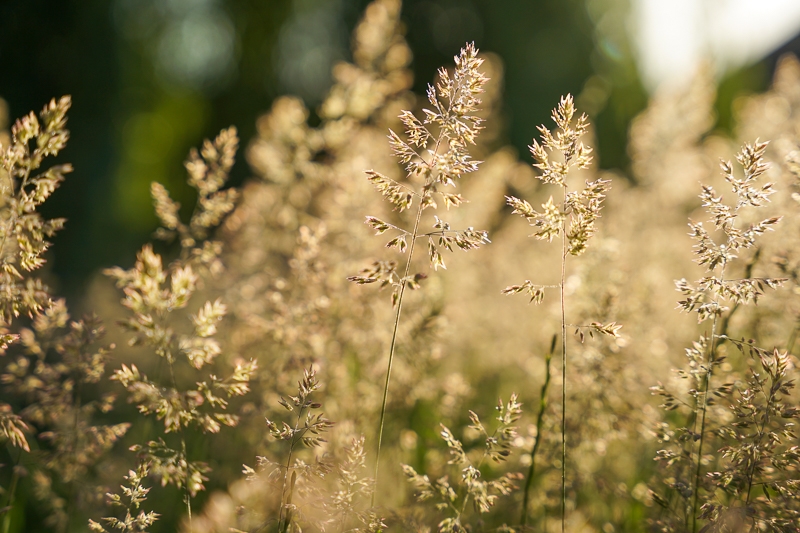
Real lawns can be left un-mowed to become even more beautiful
5. IT’S REALLY EXPENSIVE
I won’t bore you with stats on the cost of plastic grass but suffice to say that if you get some quotes for good quality fake grass installation, you’ll realise it’s not cheap. Someone I know recently had a medium-sized suburban lawn done and it cost around £10,000.
This means that if you’re considering artificial grass to save yourself maintenance time or to make it easier for you to manage because of mobility issues, you’d probably be better off putting that money aside to pay for someone to mow your living lawn for you.
As explained above, there is a lot of maintenance required for plastic lawns, and if you paid someone £40 to mow your lawn once a month through the spring and summer instead of installing plastic grass, your £10k would keep you going for more than 62 years. Even factoring in more regular mowing (which isn’t necessary) or price increases, you’re unlikely to save yourself money by getting plastic grass rather than paying someone to look after your living lawn.
If you don’t have the time or ability to brush, weed, scrub, and sweep your plastic lawn, you’ll need to factor in the cost of that work (or repairs to your plastic grass) on top of the £10k. Oh, and fake grass only has a life span of 10-20 years.
6. IT’S NOT ACTUALLY GOOD FOR KIDS
Loads of the advertising for plastic grass is that it’s ‘safe for kids’; what on Earth does this mean? Real grass is not dangerous for children.
Some advertising pitches fake grass as a solution to muddy patches caused by kids playing football or going down a slide – why are we so intolerant of a little earth that shows our kids’ playtime?
If you want to talk about safety for kids, let’s talk about the fact that fake grass is uncomfortable, and it hurts. Have you ever sat on fake grass? All but the most expensive is unbearably uncomfortable, and if you’ve fallen onto it, you’ll know it hurts more than real grass. In fact, there have been successful campaigns to keep real grass in professional sport, due to studies suggesting that plastic grass can cause more injuries. One study on young female football players found a significantly higher incident of serious injuries on artificial turf, although overall the risk of acute injuries between fake and living grass was similar.
The jury’s still out on whether plastic grass causes more injuries, but what about the injury it inflicts on children’s connection to the natural world? Playing with grass, making daisy chains, watching insects, and touching soil are all beneficial to children’s development and their capacity to care for our environment. Access to soil and living plants and grass also benefits their physical and mental health – something that Lucy Jones explores in her book Losing Eden.
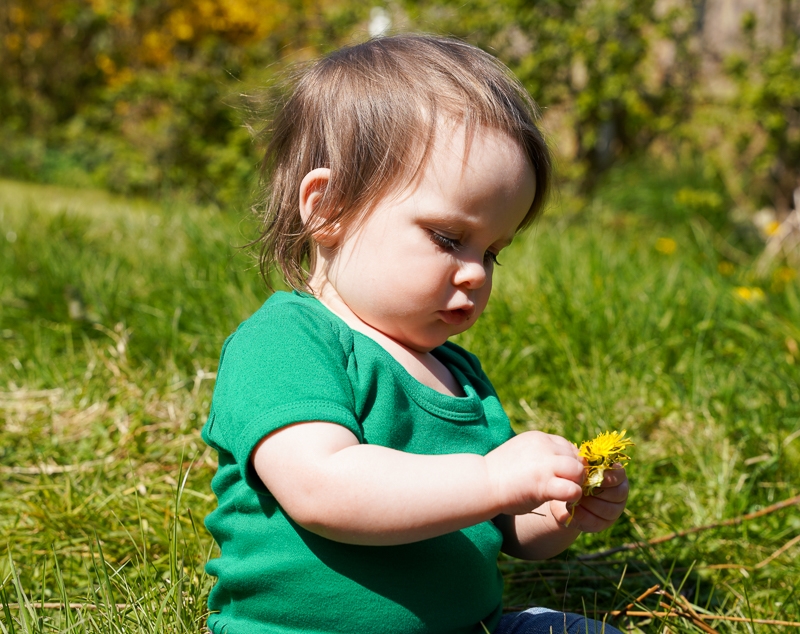
My niece enjoying my living lawn
7. IT CAUSES DRAINAGE PROBLEMS
Fake grass salespeople will tell you that properly installed plastic grass doesn’t cause any drainage issues, yet again and again it does.
In fact, the Independent reports that the growing trend for artificial lawns could be raising the risk of flooding in urban areas. More than 50% of rainfall runs straight off artificial grass – not like your living lawn, which happily absorbs most rainwater.
Think you can get away with it if you pay more? Think again. The study found that the more expensive the grass, the worse the runoff problems were.
The Climate Change Committee’s recent Independent Risk Assessment of UK Climate Risk made it clear that many more people will be at risk of flooding in the future, and urgent action is needed to improve the ability of our land to absorb rainfall. Plastic grass isn’t helping.
8. IT ENCOURAGES HARMFUL WAYS TO VIEW OUR OUTDOOR SPACE
Benedict MacDonald talks in Rebirding about the harmful effects of ‘Ecological Tidiness Disorder’ – our British obsession with obliterating the natural world to tame it into something that looks ‘neat’.
Somewhere along the way we’ve lost our appreciation for messy wildflower meadows, vibrant and diverse clover lawns, and species-rich scrubland. Many of us spend hours upon hours pruning, pulling, spraying, strimming, chopping and cutting our green spaces into species-poor, clinical dead zones, and it needs to stop.
We don’t have to let everything run wild – spaces can be environmentally friendly and still look appealing (just look at Monty Don’s gardens) – but we do need to move away from our over-manicured expectations and learn to share our space with wildlife.
The popularity of plastic grass doesn’t bode well for us retaining a connection with and appreciation for the natural world.
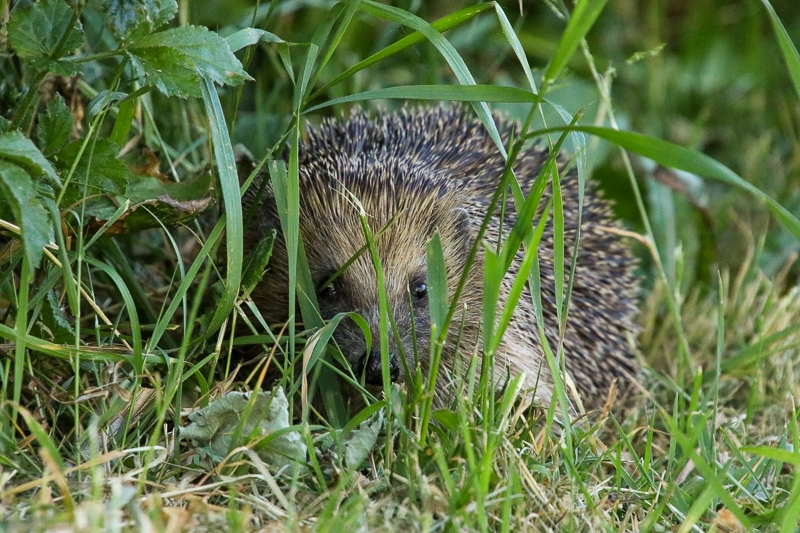
Hedgehogs can find food in real lawns
9. IT CREATES WASTE
Plastic lawns don’t biodegrade, and most of them can’t be recycled.
Where they can be recycled, that’s usually only possible at specialised facilities in central Europe. The chances of someone taking the trouble to ship their worn-out fake grass to a specialist recycling plant seems slim to none, and recycling doesn’t solve the issue of creating unnecessary waste.
10. IT LOOKS TERRIBLE
Okay, this one is purely personal opinion. Seeing plastic grass makes me feel like I’m in that dystopian future at the start of The Lorax movie where nobody has seen a living tree for years and all the grass, flowers and trees are artificial. It gives me the heebie-jeebies.
IS IT ABLEIST TO BASH PLASTIC GRASS?
It’s always important to check your privilege, especially when criticising the choices of others. Bashing plastic grass isn’t focused on criticising the choices of any individual – this post is intended to allow people to make informed decisions about artificial grass.
Having said that, I have seen allegations of ableism in response to posts on socials about the damaging effects of plastic grass. We need to recognise that some people choose artificial lawns because they are less mobile or because they have disabilities that would make it difficult for them to maintain a living lawn.
I would never dismiss such concerns out of hand. However, I don’t view these concerns as defeating the wider arguments against plastic grass. I haven’t found studies on this, but in the hundreds of testimonials and social media posts I’ve read, the majority of people opting for artificial grass are not doing so to aid their mobility restrictions. Similarly, the marketing of artificial grass doesn’t tend to focus on its use as a disability aid.
Although everyone has different circumstances and requirements, plastic grass often isn’t preferable to living grass when it comes to mobility issues. As explained above, plastic grass is prohibitively expensive, and it still requires upkeep such as sweeping, hoovering, and cleaning.
WHAT ABOUT THE ADVANTAGES?
There are several advantages of plastic grass from an environmental perspective, including reduced use of water and reduced use of fossil fuels to power mowers.
These benefits must be balanced against the harms caused and we must challenge the assumptions underlying these advantages.
For instance, whilst some people do use fossil fuels to power their mowers, many use electric mowers and are on green electricity tariffs. There's a question around whether the mowing you'd save would even outweigh the fossil fuel use that goes into manufacturing and transporting the fake grass, and many people with plastic lawns replace mowing with hoovering. Further, whilst some people do mow their lawn every week, many people mow less often.
The same goes for water use. Some people no doubt keep their lawns watered with sprinklers, like the stepmother in A Cinderella Story, but many people in the UK don’t water their lawns at all (and they don't need to be watered!).
Ultimately, plastic grass is not the solution to these issues. The solution to these issues is challenging our obsession with perfectly tidy, short, uniform grass. If we embrace longer grass, grass with flowers, and grass with different colours and textures, we can cut down our water use, fertiliser use, weedkiller use and power use without resorting to covering our outdoor space in sand and plastic.
For climates where saving water really is a benefit to artificial grass, I'm confident we can come up with greener, more exciting solutions, like using plants that have lower water requirements.
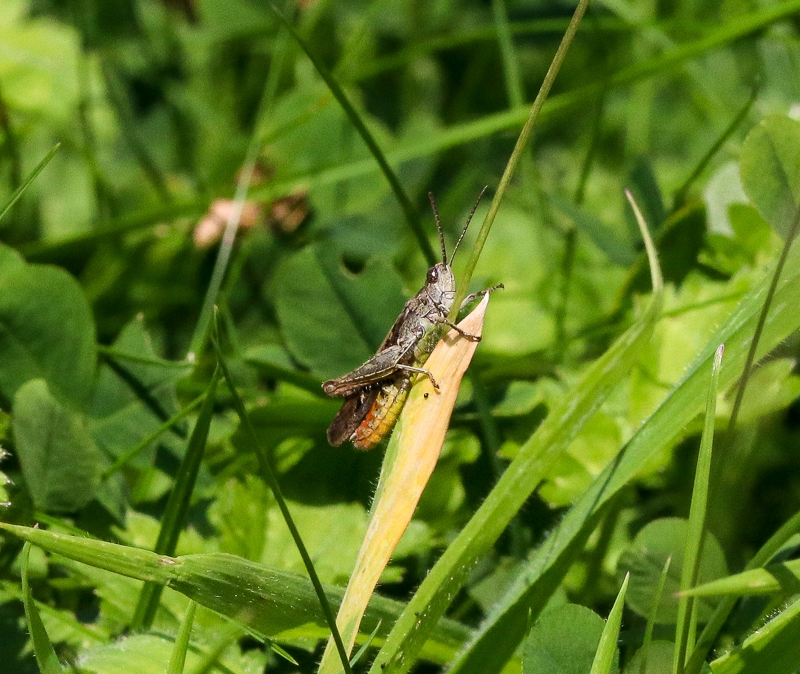
A field grasshopper in my lawn
AN INFORMATION BLIND SPOT
I said at the start that Google results for artificial grass were swamped with options to buy. Often, it’s difficult to find information about the environmental effects of an industry when there's a lot of money to be made and a lot of vested interests. The artificial grass market is expected to be worth $4.45 billion by 2022.
You remember in the Netflix documentary Cowspiracy how difficult it was for the journalists to obtain independent information about the harms caused by animal agriculture? Perhaps the same is happening here.
Even when I Google specific terms like ‘artificial grass environmental harm’ I struggle to find the scientific information in the avalanche of articles written by artificial grass sellers justifying (with no references) why artificial grass isn’t that bad. When I use Google Scholar or my university library, the avalanche is studies relating to its impact on sporting performance (there’s a lot of money in sport).
I know that there have been many news and scientific articles on the harms of artificial grass because I’ve read them – from my journal subscriptions, news apps or Twitter – but they don’t show in the Google results. In fact, when I search ‘artificial grass’ on the Guardian’s website, I have to scroll past four ads for artificial grass before I get to the paper's own articles explaining the threat fake grass poses to our wildlife and climate.
If you're looking for information on plastic grass, be aware of the source. Lots of articles praising it look like they're independent but are actually written by the plastic grass sellers.
What do you think of plastic grass? Have you managed to find much science on this? Let me know!
Share with your friends
Subscribe to learn more
Join me in exploring our natural world and cultural heritage as we learn how to protect and restore it. Get notified on my latest posts and a monthly newsletter on wider conversation topics for us to chat about.
Recent Posts
If you enjoyed this one, then you might like these too.